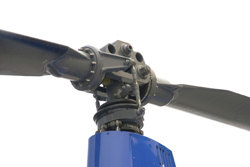Laminar flow prediction for rotor blades
The physics behind the transition from laminar to turbulent flow is much better characterised for fixed wings than it is for rotor blades. In the latter case, both rotation and cyclic pitching must be taken into account. EU-funded scientists working on the project LAMBLADE, developed theoretical and numerical tools to compute laminar base-flow parameters under unsteady conditions and to predict transition. The code takes as input the three components of the external velocity distribution on the blade surface obtained from an inviscid (neglecting viscosity effects) flow solver. Development of the numerical tools to compute the main boundary layer quantities for unsteady flow conditions faced two main challenges. One was the treatment of stagnation points where the local flow velocity is zero. The second was the occurrence of separation of the flow stream or boundary layer from the surface, forming a series of eddies. The latter is characterised by zero friction on the surface. LAMBLADE successfully addressed these issues and obtained a numerical solution describing behaviour of the unsteady boundary layer for both the 2D and 2.5D cases. Following this, researchers moved on to prediction of transition to turbulent flow. Transition analysis focused on the application of ray theory and the multiple-scale approach. The code calculates the instability amplification of a single ray (characteristic line) in space time, using the unsteady boundary layer calculations together with other parameters. To calculate multiple rays, the code is invoked multiple times leading to an effective and efficient transition prediction. Development of the numerical code describing boundary layer behaviour and the transition to turbulent flow in rotor blades has led to invaluable insights. These unprecedented tools will be particularly important in the design of laminar blades for hovercraft. This will reduce drag and thus noise and greenhouse gas emissions, contributing to sustainable and eco-friendly air transport.







